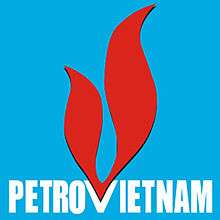Petrovietnam
PetroVietnam is the trading name of Vietnam Oil and Gas Group (PVN) (in Vietnamese: Tập đoàn Dầu khí Quốc gia Việt Nam). PetroVietnam has developed rapidly since it was established in 1977,[2] and its activities, through its various companies and wholly owned subsidiaries, now cover all the operations from oil and gas exploration and production to storage, processing, transportation, distribution and services. Wholly owned by the Vietnamese central government, it is responsible for all oil and gas resources in the country and has become its country's largest oil producer and second-largest power producer.[3]
 | |
| state owned | |
| Industry | oil and gas industry |
| Founded | 1977 |
| Headquarters | , |
| Products | oil, natural gas, coal, electricity |
| Revenue | $37 billion (2012)[1] |
| $5.4 billion (2012) | |
| Owner | Vietnam |
| Website | www |
Operations
PetroVietnam also carries out exploration activities in Malaysia, Indonesia, Mongolia, Myanmar and Algeria, and recovers oil in Iraq and Malaysia.[4]
International cooperation
In order to help pay for the costs stemming from the Deepwater Horizon explosion, BP plans to sell its stakes in gas and oil properties in Vietnam. It maintains joint ownership of such projects — Lan Tay-Lan Do gas field and Nam Con Son pipeline — with ONGC, PetroVietnam, and ConocoPhillips. Moreover, its partners will be given priority when purchasing its shares should Hanoi approve the transaction.[5] India has expressed interest in buying BP's assets to secure needed energy resources for its fast-growing economy.[3]
In 2010, PetroVietnam Group has secured $1 billion loan from government bond proceeds and BNP Paribas for the Dung Quat oil refinery Plant No 1, in Vietnam, which began operating at 100% production capacity in August 2010.[6]
Subsidiaries and Joint-ventures
PetroVietnam has several subsidiaries:[7]
- Petrovietnam Exploration Production Corporation (PVEP)
- Petrovietnam Gas Corporation (PV Gas)
- Vietnam Steel Gas Pipeline Joint-Stock Corporation (PV Pipe)[8]
- Petrovietnam Oil Corporation (PV Oil)
- Petrovietnam Power Corporation (PV Power)
- Binh Son Refinery Ltd. (BSR)
- Petec Trading and Investment Corporation
PetroVietnam holds controlling stakes in the following companies:
- PetroVietnam Drilling & Well Services Joint Stock Corporation (PV Drilling)
- PetroVietnam Technical Service Joint Stock Corporation (PTSC)
- PetroVietnam Transportation Joint Stock Corporation (PV Trans)
- PetroVietnam Finance Joint Stock Corporation (PVFC)
- PetroVietnam Insurance Joint Stock Corporation (PVI)
- PetroVietnam General Service Joint Stock Corporation (Petrosetco)
- PetroVietnam Construction Joint Stock Corporation (PVC)
- PetroVietnam Fertilizer and Chemicals Joint Stock Corporation (PVFCCo)
- Drilling Mud Joint Stock Corporation (DMC)
- Joint Venture Vietsovpetro (VSP)
- PetroVietnam Petrochemicals and Fibre Joint Stock Company (PV Tex), a joint-venture set up with textile manufacturer Vinatex to build Vietnam's first polyester fiber plant. The factory will be located in Haiphong and use by-products from oil-refining.[9]
- Vietnam Energy Inspection Joint Stock Company (EIC)
- Phuoc An Port Construction and Investment Joint Stock Company (PAP)
- Petrovietnam Construction Investment Consultant Joint Stock Company (PCIC)

Together with Gazprom the company has established Vietgazprom.[10]
References
- "PVN lãi gần 5,4 tỉ đô la Mỹ". The Saigon Times. December 27, 2012. Archived from the original on December 30, 2013. Retrieved December 28, 2012.
- Egal. "PVN Internet". www.pvn.vn. Retrieved April 11, 2018.
- Sharma, Rakesh (July 21, 2010). "India Interested In Buying BP Assets In Vietnam - Oil Minister". Wall Street Journal. Retrieved July 25, 2010.
- http://www.gazprom.com/eng/news/2006/11/21623.shtml Archived September 28, 2007, at the Wayback Machine
- "Who will buy BP's property in Vietnam?". Look at Vietnam. July 23, 2010. Retrieved July 25, 2010.
- "PetroVietnam secures $1 billion loan to develop Dung Quat oil refinery". World Construction Network. Retrieved September 29, 2010.
- "Vietnam National Oil and Gas Group". english.pvn.vn. Archived from the original on July 19, 2010. Retrieved April 11, 2018.
- "PV Pipe sản xuất ống thép dầu khí đầu năm 2013". The Saigon Times. October 16, 2012. Archived from the original on March 4, 2016. Retrieved October 19, 2012.
- "PVTex to operate first polyester fiber project early 2011". The Saigon Times. May 14, 2010. Archived from the original on October 6, 2011. Retrieved July 6, 2011.
- "Vietgazprom to hire Energy Searcher". Upstream Online. NHST Media Group. December 15, 2011. (subscription required). Retrieved December 15, 2011.
External links
| Wikimedia Commons has media related to Petrovietnam. |

